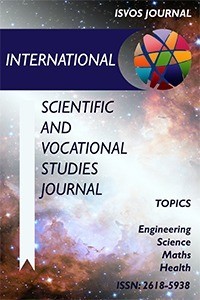An Exploration of Student Misconceptions in Electrical and Electronics Engineering Department
Misconceptions, Improving Classroom Teaching, Teaching/Learning Strategies
An Exploration of Student Misconceptions in Electrical and Electronics Engineering Department
___
- Arons A. B. (1990). A guide to introductory physics teaching (3rd ed.). New York: Wiley Inc., 328-335.
- Basili P. A., Sanford J. P. (1991). Conceptual Change Strategies and Cooperative Group Work in Chemistry Journal of Research in Science Teaching, 28(4), 293-304.
- Champagne, et al. (1983). Native Knowledge and Science Learning Research in Science and Technological Education, 1(2), 173-183.
- Chi M.T.H. (1992). Conceptual change within and across ontological categories Examples from learning and discovery in science (2nd ed.). University of Minnesota Press, 129-160.
- Clement J. J. (1977). Some Types of Knowledge Used in Understanding Physics (1st ed.). University of Massachusetts: Department of Physics and Astronomy.
- D’Ambrosio B. S., Campos T. M. M. (1990). Preservice Teachers’ Representations of Children’s Understanding of Mathematical Concepts: Conflict and Conflict Resolution Educational Studies in Mathematics, 23, 213-230.
- Esiobu G. O., Soyibo K. (1995). Effects of concept and vee mappings under three learning modes on students’ cognitive achievement in ecology and genetics Journal of Research in Science Teaching, 32, 971-995.
- Fisher K. (1985). A Misconception in Biology: Amino Acids and Translation Journal of Biology Education, 22, 53-62.
- Gal-Ezer J., Zur E. (2004). The efficiency of algorithms—misconceptions Computers & Education, 42(3), 215-226.
- Gürbüz R., Birgin O. (2012). The effect of computer-assisted teaching on remedying misconceptions: The case of the subject probability Computers & Education, 58(3), 931-941.
- Hake R. R. (1992). Socratic Pedagogy in the Introductory Physics Laboratory The Physics Teacher, 33, 1-7.
- Herman G. L., Loui M. Zilles C. (2011). Students' Misconceptions About Medium-Scale Integrated Circuits IEEE Transactions on Education, 54(4), 637 – 645.
- John P. S., Andrea A. D., Roschelle J. (1994). Misconceptions Reconceived: A Constructivist Analysis of Knowledge in Transition The Journal of the Learning Sciences, 3(2), 115-163.
- McDermott D. (1991). Regression planning International Journal of Intelligent Systems, 6(4), 357-416.
- Mestre J. (1987). Why should mathematics and science teachers be interested in cognitive research findings? New York: The Collage Board Academic Connections, 3-5, 8-11.
- Novak J. D., Gowin D. B. (1984). Learning How to Learn (2nd ed.). New York: Cambridge University Press.
- Papastergiou M. (2008). Are Computer Science and Information Technology still masculine fields? High school students’ perceptions and career choices Computers & Education, 51(2), 594-608.
- Posner G. J., Strike K. A., Hewson P. W., and Gertzog W. A. (1982). Accomodation of a Scientific Conception : Toward a Theory of Conceptual Change Science Education, 66, 211-227.
- Posner G. J., Gertzog W. A. (1982). The Clinical Interview and the Measurement of Conceptual Change Science Education, 66, 195-209.
- Resnick L. (1983). Mathematics and Science Learning: A new Conception Science Education, 220, 477-478.
- Stavy R., Berkowitz B. (1980). Cognitive Conflict as a Basis for Teaching Quantitative Aspects of the Concept of Temperature Science Education, 64, 679-692.
- ISSN: 2618-5938
- Yayın Aralığı: Yılda 2 Sayı
- Başlangıç: 2017
- Yayıncı: Umut SARAY
The Mesozoic Stratigraphy And Ammonite Fauna Of Ladik-Akdag (Samsun) Territory
Bengi ŞANLI, Elif TURNA DİLSEL
Performance Analysis of Storage, Grid Connected Hybrid Photovoltaic System
Anselm of Canterbury and Scholastic Thought
Muhammed TAŞOVA, Gazanfer ERGÜNEŞ
A Comparison of Five Methods for Missing Value Imputation in Data Sets
Complementary Coded Waveforms Sets in Marine Radar Application
Analytical Design of PI Controllers for First Order plus Time Delay Systems
The Mesozoic Stratigraphy and Ammonite Faune for Niksar-Erbaa (Tokat) Territory
